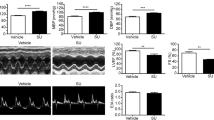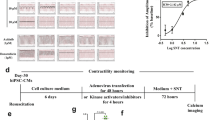Abstract
Sunitinib is used extensively in the treatment of metastatic renal cell carcinoma and imatinib-resistant gastrointestinal stromal tumors. However, the undesirable cardiotoxic effects of sunitinib, such as congestive heart failure and hypertension, limit its use in the clinical setting. As multiple receptor tyrosine kinases are inhibited by sunitinib, it raises a question as to which target mediates sunitinib-induced cardiotoxicity. Here, we reported that the injection of fibroblast growth factor 2 (FGF2) mRNA into one- to two-cell stage embryos protected against sunitinib-induced cardiotoxicity in zebrafish. In addition, FGF2 significantly prevented sunitinib-induced cardiotoxicity in cardiomyoblast H9c2 cells, possibly via activating the PLC-γ/c-Raf/CREB pathway. Importantly, FGF2 did not compromise the antitumor activity of sunitinib in Caki-1 and OS-RC-2 renal cell carcinoma cells. Molecular docking simulations further revealed an interaction between the tyrosine kinase domain of FGF receptor 1 (FGFR1) and sunitinib. Taken together, our results clearly demonstrated that FGF2 inhibition plays an important role in sunitinib-induced cardiotoxicity both in vitro and in vivo. This study also provided a basis for further research on sunitinib-induced cardiotoxicity and may allow rational design of new sunitinib derivatives with fewer or weak cardiotoxic effects.





Similar content being viewed by others
Abbreviations
- BA:
-
Bulbus arteriosus
- CREB:
-
cAMP response element-binding protein
- FGF2:
-
Fibroblast growth factor 2
- Hpf:
-
Hours post-fertilization
- LDH:
-
Lactate dehydrogenase
- PLC:
-
Phospholipase C
- SV:
-
Sinus venosus
- TKI:
-
Tyrosine kinase inhibitor
References
Karaman, M. W., Herrgard, S., Treiber, D. K., Gallant, P., Atteridge, C. E., Campbell, B. T., et al. (2008). A quantitative analysis of kinase inhibitor selectivity. Nature Biotechnology, 26, 127–132.
Blay, J. Y. (2010). Pharmacological management of gastrointestinal stromal tumours: an update on the role of sunitinib. Annals of Oncology, 21, 208–215.
Chu, T. F., Rupnick, M. A., Kerkela, R., Dallabrida, S. M., Zurakowski, D., Nguyen, L., et al. (2007). Cardiotoxicity associated with tyrosine kinase inhibitor sunitinib. Lancet, 370, 2011–2019.
Telli, M. L., Witteles, R. M., Fisher, G. A., & Srinivas, S. (2008). Cardiotoxicity associated with the cancer therapeutic agent sunitinib malate. Annals of Oncology, 19, 1613–1618.
Force, T., & Kolaja, K. L. (2011). Cardiotoxicity of kinase inhibitors: the prediction and translation of preclinical models to clinical outcomes. Nature Reviews Drug Discovery, 10, 111–126.
Chan, J., & Mably, J. D. (2011). Dissection of Cardiovascular Development and Disease Pathways in Zebrafish. In K. T. Chang & K. T. Min (Eds.), Progress in molecular biology and translational science: animal models of human disease (Vol. 100, pp. 111–153). San Diego: Elsevier Academic Press Inc.
Chen, J. N., Haffter, P., Odenthal, J., Vogelsang, E., Brand, M., van Eeden, F. J., et al. (1996). Mutations affecting the cardiovascular system and other internal organs in zebrafish. Development, 123, 293–302.
Challa, A. K., & Chatti, K. (2013). Conservation and early expression of zebrafish tyrosine kinases support the utility of zebrafish as a model for tyrosine kinase biology. Zebrafish, 10, 264–274.
Cheng, H., Kari, G., Dicker, A. P., Rodeck, U., Koch, W. J., & Force, T. (2011). A novel preclinical strategy for identifying cardiotoxic kinase inhibitors and mechanisms of cardiotoxicity. Circulation Research, 109, 1401–1409.
Powers, C. J., McLeskey, S. W., & Wellstein, A. (2000). Fibroblast growth factors, their receptors and signaling. Endocrine-Related Cancer, 7, 165–197.
Jiang, Z. S., Padua, R. R., Ju, H., Doble, B. W., Jin, Y., Hao, J., et al. (2002). Acute protection of ischemic heart by FGF-2: Involvement of FGF-2 receptors and protein kinase C. American Journal of Physiology Heart and Circulatory Physiology, 282, H1071–H1080.
Marais, E., Genade, S., & Lochner, A. (2008). CREB activation and ischaemic preconditioning. Cardiovascular Drugs and Therapy, 22, 3–17.
Kumar, R., Crouthamel, M. C., Rominger, D. H., Gontarek, R. R., Tummino, P. J., Levin, R. A., & King, A. G. (2009). Myelosuppression and kinase selectivity of multikinase angiogenesis inhibitors. British Journal of Cancer, 101, 1717–1723.
Huang, C. J., Tu, C. T., Hsiao, C. D., Hsieh, F. J., & Tsai, H. J. (2003). Germ-line transmission of a myocardium-specific GFP transgene reveals critical regulatory elements in the cardiac myosin light chain 2 promoter of zebrafish. Developmental Dynamics, 228, 30–40.
Westerfield, M. (1995). The zebrafish book: A guide for the laboratory use of zebrafish (Danio rerio), 3rd Edition Eugene (pp. 267–272). OR: University of Oregon.
Kim, B., Huang, G., Ho, W. B., & Greenspan, D. S. (2011). Bone morphogenetic protein-1 processes insulin-like growth factor-binding protein 3. Journal of Biological Chemistry, 286, 29014–29025.
Antkiewicz, D. S., Burns, C. G., Carney, S. A., Peterson, R. E., & Heideman, W. (2005). Heart malformation is an early response to TCDD in embryonic zebrafish. Toxicological Sciences, 84, 368–377.
Cui, G., Shan, L., Hung, M., Lei, S., Choi, I., Zhang, Z., et al. (2013). A novel Danshensu derivative confers cardioprotection via PI3 K/Akt and Nrf2 pathways. International Journal of Cardiology, 168, 1349–1359.
Mohammadi, M., McMahon, G., Sun, L., Tang, C., Hirth, P., Yeh, B. K., et al. (1997). Structures of the tyrosine kinase domain of fibroblast growth factor receptor in complex with inhibitors. Science, 276, 955–960.
Jain, A. N. (2003). Surflex: Fully automatic flexible molecular docking using a molecular similarity-based search engine. Journal of Medicinal Chemistry, 46, 499–511.
French, K. J., Coatney, R. W., Renninger, J. P., Hu, C. X., Gales, T. L., Zhao, S. F., et al. (2010). Differences in effects on myocardium and mitochondria by angiogenic inhibitors suggest separate mechanisms of cardiotoxicity. Toxicologic Pathology, 38, 691–702.
Marcolino, M. S., Ribeiro, A. L., Clementino, N. C. D., Nunes, M. D. P., Barbosa, M. M., Silva, M., et al. (2011). The use of imatinib mesylate has no adverse effects on the heart function. Results of a pilot study in patients with chronic myeloid leukemia. Leukemia Research, 35, 317–322.
Jiang, Z. S., Jeyaraman, M., Wen, G. B., Fandrich, R. R., Dixon, I. M., Cattini, P. A., & Kardami, E. (2007). High- but not low-molecular weight FGF-2 causes cardiac hypertrophy in vivo; possible involvement of cardiotrophin-1. Journal of Molecular and Cellular Cardiology, 42, 222–233.
Hescheler, J., Meyer, R., Plant, S., Krautwurst, D., Rosenthal, W., & Schultz, G. (1991). Morphological, biochemical, and electrophysiological characterization of a clonal cell (H9c2) line from rat heart. Circulation Research, 69, 1476–1486.
Anestopoulos, I., Kavo, A., Tentes, I., Kortsaris, A., Panayiotidis, M., Lazou, A., & Pappa, A. (2013). Silibinin protects H9c2 cardiac cells from oxidative stress and inhibits phenylephrine-induced hypertrophy: potential mechanisms. Journal of Nutritional Biochemistry, 24, 586–594.
House, S. L., Newman, G., & Schultz, J. J. (2010). Human recombinant low molecular weight fibroblast growth factor 2 protects the heart from reperfusion injury through activation of fgf receptors and nitric oxide signaling. Annals of Emergency Medicine, 56, S5–S5.
House, S. L., Melhorn, S. J., Newman, G., Doetschman, T., & Schultz, J. E. (2007). The protein kinase C pathway mediates cardioprotection induced by cardiac-specific overexpression of fibroblast growth factor-2. American Journal of Physiology-Heart and Circulatory Physiology, 293, H354–H365.
Chen, X. Q., Chen, L. L., Fan, L., Fang, J., Chen, Z. Y., & Li, W. W. (2014). Stem cells with FGF4-bFGF fused gene enhances the expression of bFGF and improves myocardial repair in rats. Biochemical and Biophysical Research Communications, 447, 145–151.
Acknowledgments
This work was supported by grants from the Science and Technology Development Fund Macao SAR, China (Grant No. 014/2011/A1) and the National Natural Science Foundation of China (Grant No. 31301192).
Conflict of interest
The authors declare that there are no conflicts of interest.
Author information
Authors and Affiliations
Corresponding author
Additional information
Guozhen Cui and Huanxian Chen have contributed equally to this work.
Rights and permissions
About this article
Cite this article
Cui, G., Chen, H., Cui, W. et al. FGF2 Prevents Sunitinib-Induced Cardiotoxicity in Zebrafish and Cardiomyoblast H9c2 Cells. Cardiovasc Toxicol 16, 46–53 (2016). https://doi.org/10.1007/s12012-015-9315-1
Published:
Issue Date:
DOI: https://doi.org/10.1007/s12012-015-9315-1




